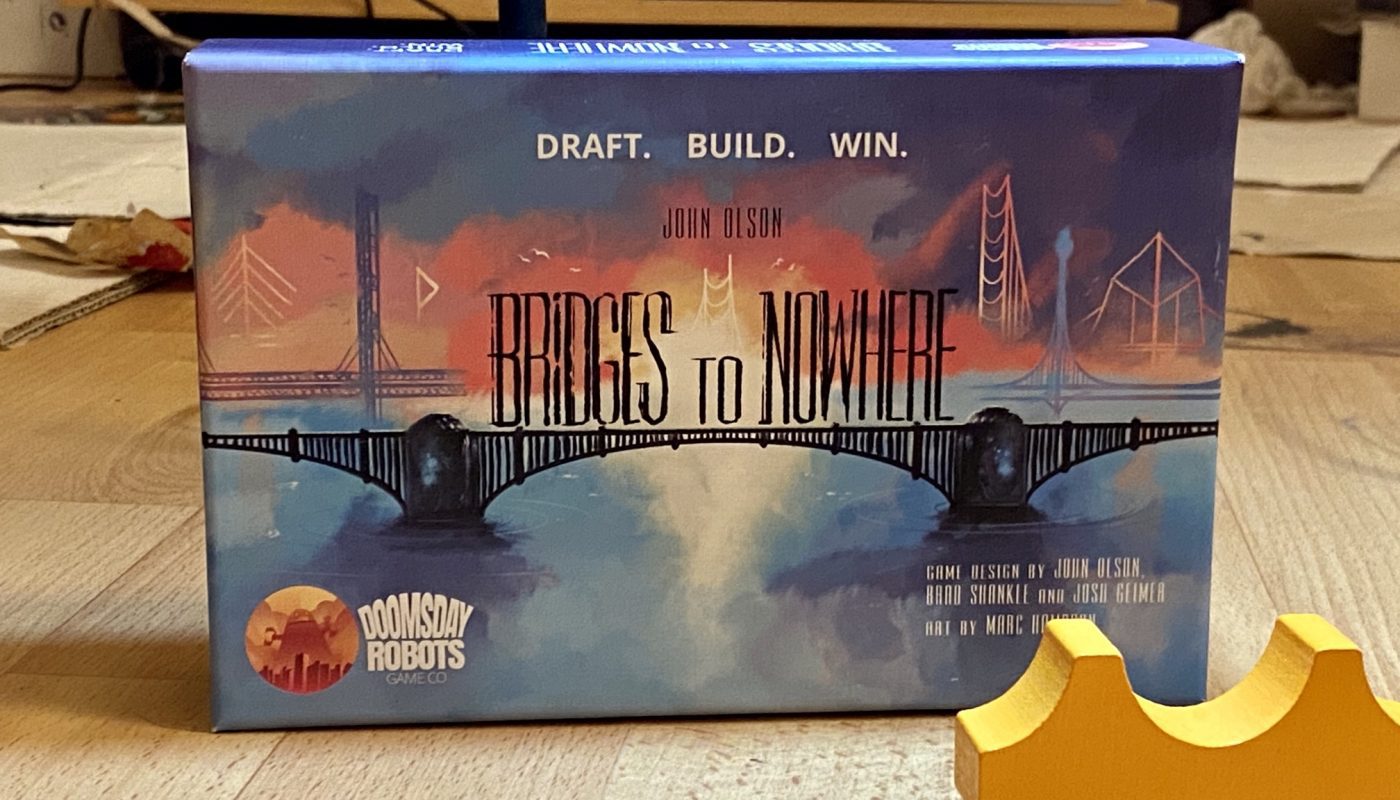A short disclaimer before you read my board game analysis
As an avid euro gamer and hardcore Legend of the Five Rings (L5R) LCG player, my reviews may reflect a preference for these styles, and I may not cover solo games/variants extensively. Please note that my personal remarks are based on my gaming experiences, and I aim to provide honest insights within the scope of my preferences.
Bridges to Nowhere is one of many micro-games I have missed from Kickstarter. Once I found someone on eBay who wanted to sell this game, it was an auto-purchase for me. This game from Doomsday Robots didn’t get many spotlights despite its magical artwork by Marc Hampson. Hmmm… I wonder why. Perhaps what Mehmet Murat İldan said is true…
The fate of the bridges is to be lonely; because bridges are to cross not to stay!
Mehmet Murat İldan
The duo John Olson and Bryn Smith designed and released Bridges to Nowhere to Kickstarter in Q2 2017. After three years, I got the chance to at last try this baby. It’s a bit hard to find the retail version, too, in Germany. How did this game fare? Let’s look at this thoroughly.

Bridges to Nowhere’s quick rule
We are engineers competing for lucrative contracts by designing impressive bridges over certain rounds. Bridges to Nowhere consists of Drafting and Building phases. During the Drafting phase, each player takes turn taking Bridge or Monument cards until they have certain amount of cards on their hands. This part varies depending on the number of players. Any cards left untaken are then discarded.
The drafted cards are then used in the Building phase; all players simultaneously design their bridge.
The cards unused will be discarded as well. There are some rules to be respected while building the bridge.
The bridge should have the segments that fit the bridge’s and pillar’s type. A complete bridge begins and ends up with the Pillar cards. There is a number printed on the Bridge card; the bridge segments should be built in ascending or descending order; this may change direction only once on each complete bridge. Anyway, you can build a new pillar upon the existing one. There are more of it (contracts etc.) but these are the most fundamental parts. You can always refer to their site for the complete rule.
When all the Bridge cards from the deck are drafted, the game ends. Each player counts all points they earn through the bridge building and so on. Remember that incomplete bridge does not contribute anything. The player who earns the most points wins the game!
Remarks
Bridges to Nowhere is a fast-paced, micro board game with card drafting as its core mechanic. This would be a perfect fit in your travel backpack because of its tiny-bit size. If you are someone adventurous who wants to introduce the fun of board games during your journey, building bridges might be another fun activities to connect with some strangers on the train. Let’s break it down a little more, shall we?
Neat rulebook and quick sessions
The rule is easy to follow and all players will understand in no time. The rulebook is really concise and you can digest it thoroughly. The gameplay is pretty short so it would not be boring and hard for some new players. I think it took us like around 10 minutes with 2 players and less than 25 minutes for the full 4 players gameplay.
Anyway, Bridges to Nowhere has already stolen one spot in my gateway game. If you are looking for other microgames, you might be interested in Hatsuden, Troia, and Crimson Company.
Jumping to the artwork… And components, a bit
Dreamy and eye-catching, I don’t know how one can withstand the urge to love this game when he/she catches the glimpse of the box. The illustration on the cards is also magnificent; they kept it simple and cheerfully just-about-right. The difference between the bridges’ segments is clear and it does not hinder the game at all. Kudos to Marc Hampson!
I don’t really have any problem with the components; except for that huge first player token. Well, it could have been smaller to save cost and space considering its purpose which somewhat cosmetic.
And now we’re going to what matters the most…
The gameplay

Bridges to Nowhere is more a strategy game and devising plans rather than tactical despite its card drafting nature. It does not mean this game lacks the latter aspect at all. Drafting means you might not get the cards you need. Hence, some adaptations based on the resources you have are crucial.
Strategically speaking, you have to manage your Pillar cards. If you cannot plan your bridge well, you will really waste the cards you have drafted because you cannot complete it somehow; this happens often especially when players build double- or triple-decker bridge. The latter one is pretty much statistically impossible in a two-player session, though. The shorter session span does not give you adequate time to build the basis for the third layer.
More insight into the tactical side: you have to make good from the cards available on the table. The cards you need do not always appear whenever you need it and you cannot save the cards for later use. It forces you to use whatever resources you have currently on-hand. Do you see two good cards for your bridge appear simultaneously in one draft? Well, too bad… Expect that the card you don’t draft during your turn will never be yours in the future! Since this game offers open information, the opponents will be able to predict your next move, eventually.

Main target
Definitely not for players who seek for medium to heavy game. Bridges to Nowhere is more for those who casually play light games to kill time. This might be a good option to introduce new players to the board/card game environment as well.
Final thoughts
Bridges to Nowhere really packs a punch in a small package. Great artwork, neat and simple gameplay, and some planning. Once you put your Bridge card somewhere, it stays there and you have to stick on that plan. If you like Sushi Go or other games alike, I think Bridges to Nowhere will suit your taste.
I am a full-time food technologist during weekdays. However, when the calendar hits weekends, I transform into an avid board gamer. I am a hardcore Legend of the Five Rings (L5R) LCG player from Fantasy Flight Games (FFG). Current hobby: buying board games. My shelf of shame’s list is getting longer, thanks to you, Kickstarter.







